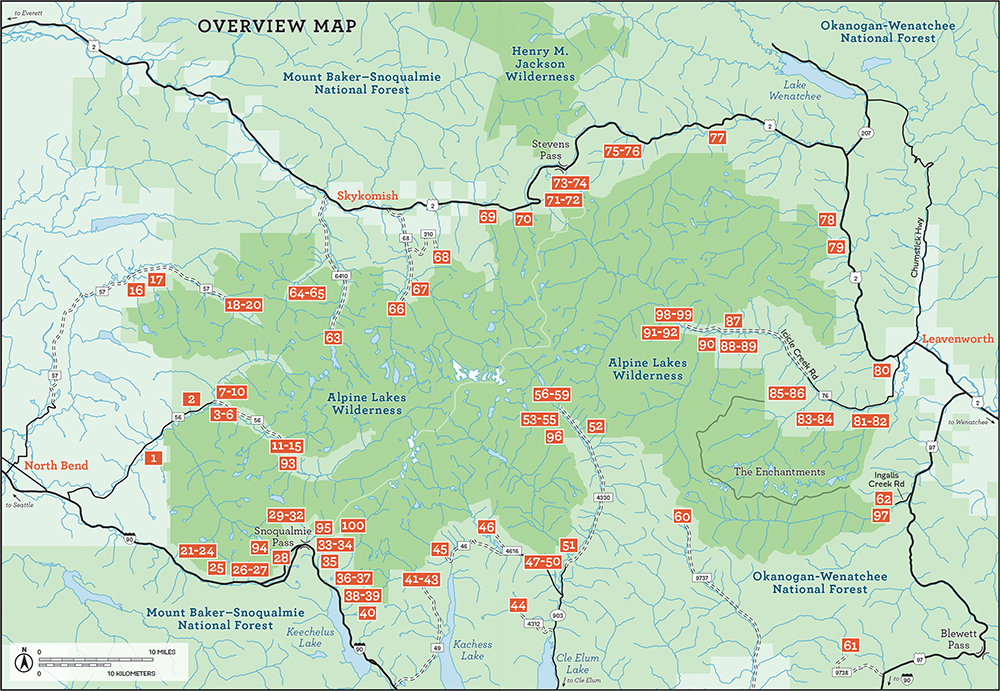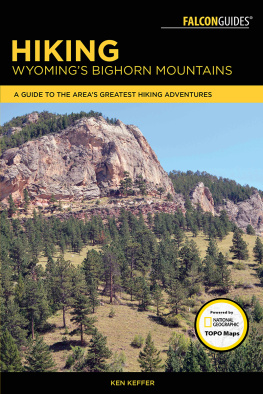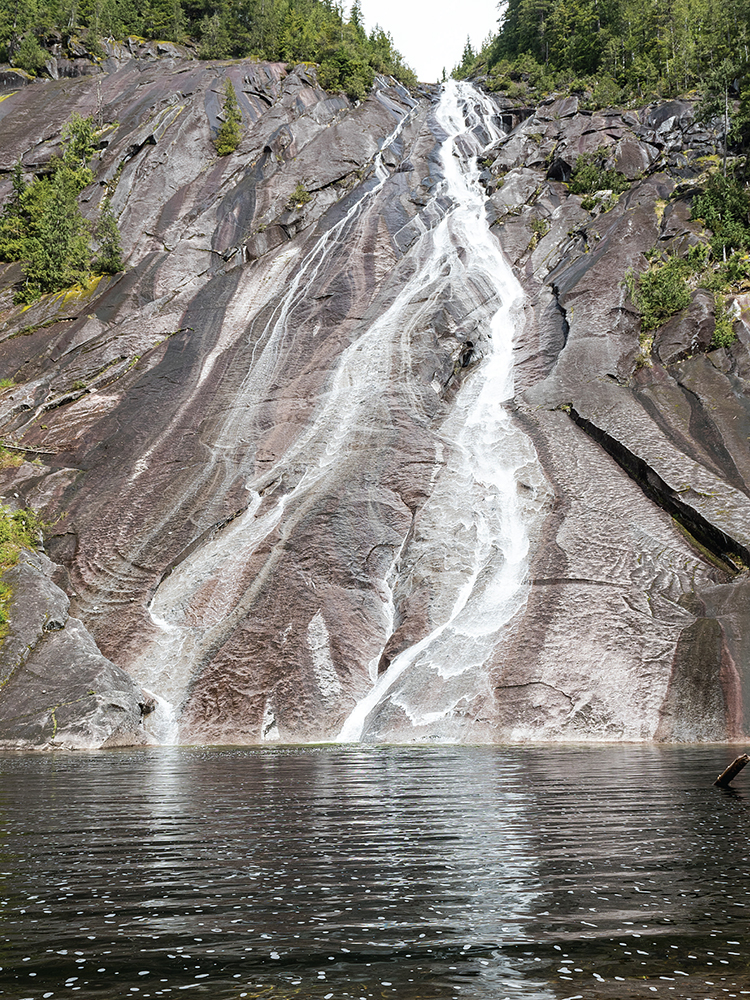ALPINE LAKES
WILDERNESS
ALPINE LAKES
WILDERNESS
THE COMPLETE HIKING GUIDE
NATHAN BARNES & JEREMY BARNES
TO ALL OUR CONSTANT TRAIL COMPANIONS, BOTH OLD AND NEW
MOUNTAINEERS BOOKS is dedicated to the exploration, preservation, and enjoyment of outdoor and wilderness areas.
1001 SW Klickitat Way, Suite 201, Seattle, WA 98134
800-553-4453, www.mountaineersbooks.org
Copyright 2019 by Nathan and Jeremy Barnes
All rights reserved. No part of this book may be reproduced or utilized in any form, or by any electronic, mechanical, or other means, without the prior written permission of the publisher.
Mountaineers Books and its colophon are registered trademarks of The Mountaineers organization.
Printed in China
Distributed in the United Kingdom by Cordee, www.cordee.co.uk
First edition, 2019
Copyeditor: Kris Fulsaas
Cover and book design: Jen Grable
Cartographer: Lohnes+Wright
Cover photographs, front: Isolation Lake gleams below Little Annapurna in the Upper Enchantments ().
Frontispiece: Gem Lake from the High Lakes Trail en route to Wildcat Lakes ()
Last page: Looking east from Putrid Petes Peak () along the ridge to Mount Defiance
The background maps for this book were produced using the online map viewer CalTopo. For more information, visit caltopo.com.
Library of Congress Cataloging-in-Publication Data is available at https://lccn.loc.gov/2018044987
Mountaineers Books titles may be purchased for corporate, educational, or other promotional sales, and our authors are available for a wide range of events. For information on special discounts or booking an author, contact our customer service at 800-553-4453 or .
Printed on FSC-certified materials
ISBN (paperback): 978-1-68051-077-5
ISBN (ebook): 978-1-68051-078-2
CONTENTS
HIKE FINDER






Otter Falls tumbles down a natural granite spillway into Lipsy Lake ().
INTRODUCTION
A sprawling, nearly 415,000-acre wonderland, the Alpine Lakes Wilderness encompasses oldgrowth forest, glacier-dredged creek valleys, and ice-sharpened peaks. Bounded on the north by Highway 2 and on the south by Interstate 90, the wilderness straddles the Cascade Crest, extending nearly to North Bend in the west and near Leavenworth in the east. It includes the section of the Pacific Crest National Scenic Trail (PCT) from Snoqualmie Pass to Stevens Pass, as well as the renowned Enchantments surrounding Mount Stuart.
Scattered throughout this wild and rugged landscape lie the glittering namesake alpine waters; more than seven hundred lakes, tarns, ponds, and pools are tucked in the wilderness. The stunning mountaintops and lakesides carved by geological forces and glaciation have drawn people for generations. The centuries of visitors, from indigenous peoples and prospectors to surveyors and PCT through-hikers, have left their mark: a system of trails has developed that today covers more than 600 miles.
The Alpine Lakes Wilderness includes a wide variety of flora and fauna, with stark differences between the wetter western side of the Cascades and the more arid portions on the eastern side of the mountain passes. Entire books are dedicated to this complex and diverse wilderness environment, exploring its climate, geology, wildlife, forests, and geography. Such books are fantastic resources for deepening visitors understanding of the wilderness and digging into the finer details of what the wilderness holds (see the Bibliography at the end of this book). Thus, this guide intentionally avoids technical terms, scientific names, and extensive natural-history detail to focus instead on the experience of hiking the trails and the lore associated with them.
The trails and their stories are all connected by the overarching history of the Alpine Lakes Wilderness. Created in 1976, the area encompassed by the wilderness has not always enjoyed the protection and safeguards it has today. The scars left by mining, logging, and industry hint at how close this now-treasured wilderness came to becoming something much smaller and quite different. The gripping tale of how a scrappy group of conservationists, wilderness protectors, and trail stewards came together in 1968 to form what would become the Alpine Lakes Protection Society (ALPS) and spearhead the unlikely creation of the Alpine Lakes Wilderness is fascinating. Spurred by logging, road projects, and the prospect of a shrinking wilderness isolated to rocky islands above the tree line, ALPS spent years battling the US Forest Service, lobbying Congress, and standing up to opposing interest groups to protect this unique landscape.
While ALPS succeeded in creating the Alpine Lakes Wilderness, its work is ongoing and will never be complete. New challenges continue to arise, and the legacy of private ownership means that wilderness advocacy is still very much needed. Remember that the hikes in this guide and the majestic landscape the trails travel through exist because of the tireless efforts of past protectors. When hiking these trails, treat the wilderness with respect, recognizing how hard people fought to preserve the opportunity for everyone to enjoy it. Better yet, find ways to connect with advocates and play a part in continuing the work of protecting wild places.
A yellow-pine chipmunk in the eastern Cascades
LAND MANAGERS
The Alpine Lakes Wilderness spans two separate national forests, divided more or less along the Cascade Crest: to the west is the Mount BakerSnoqualmie National Forest, while to the east is the Okanogan-Wenatchee National Forest. The US Forest Service divides each of these national forests into two ranger districts each; for contact information for these four ranger districts, see the list at the back of this book. The Forest Service provides helpful pamphlets on wilderness regulations and guidelines that can be found on the Forest Service websites also listed in the back of this book. An overnight in the Enchantment Lakes area (Hikes 8186) requires an additional permit process, outlined on the Forest Service website. The wilderness regulations and permit requirements change frequently enough that it is not prudent to reproduce them here. While many guidebooks try to provide that information as a service to readers, they become quickly out of date, and bad information can ruin a carefully planned backpacking trip. Instead, hikers and backpackers should review the regulations and permit requirements every season to keep up with any changes.





















